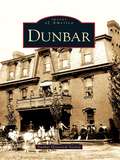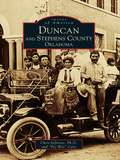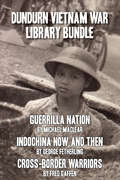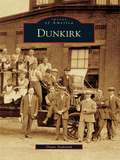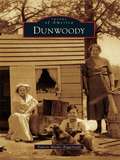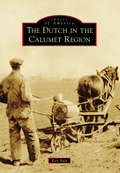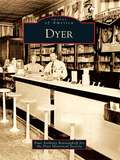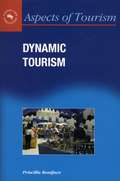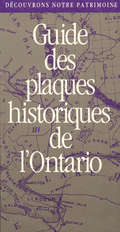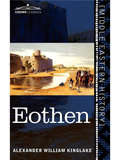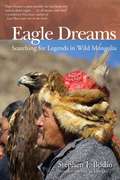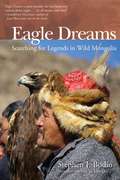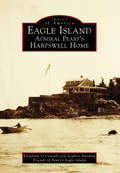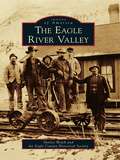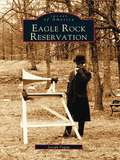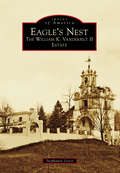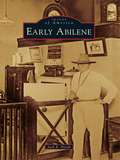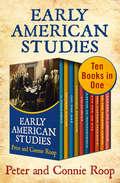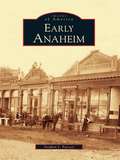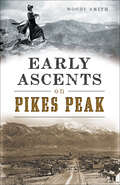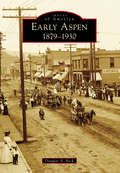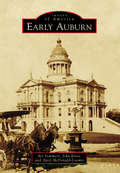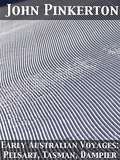- Table View
- List View
Dunbar (Images of America)
by Dunbar Historical SocietySettled in the 1790s and incorporated in 1883, Dunbar was named for Col. Thomas Dunbar, who along with Gen. Edward Braddock and George Washington came to the area in 1755 to take back Fort Duquesne. In 1791, Isaac Meason started the Union Furnace, marking the beginning of the industrial growth that became Dunbar's lifeblood for more than a century. Vintage photographs in Dunbar capture the town's industry, tragedies such as the Hill Farm Mine disaster, faith, weddings, pastimes that entertained young and old alike, intriguing people, and beautiful buildings that stand as a testament to a more prosperous age. Today tourism opportunities such as the Sheepskin Trail, the Fayette Central Railroad Tourist Train, and the coke oven project at the Dunbar Historical Society's park are helping the community reinvent itself and provide a new future for the little town.
Duncan and Stephens County, Oklahoma
by Chris Jefferies Pee Wee" CaryIncluding some of Oklahoma's earliest and most productive oil fields, Duncan and Stephens County played a major role in the development of America's oil industry. Through historic images, this book focuses on the two themes that emerge from the area's past: first, the settlement, growth, and development of communities with strong, progressive pioneer heritage; and second, the discovery of oil in the late teens, and the development of a petroleum industry with a worldwide reach and impact.Using primarily the archives of the Stephens County Historical Museum, the authors selected photographs that illustrate the two themes of community and oil, and how they impact each other. Highlights include the growth and development of Duncan, Marlow, and Comanche; prosperity from the oil boom; the strongsense of community through the Depression; service in both World War I and World War II; renewed growth following World War II; and contemporary efforts to strengthen the communities.
Dundurn Vietnam War Library Bundle: Guerrilla Nation / Indochina Now and Then / Cross-Border Warriors
by George Fetherling Michael Maclear Fred GaffenThe Vietnam War was a regional conflict that turned into an epic confrontation between ideologies, leaving deep scars on the psyches of nations that fought and long-lasting physical damage to Vietnam itself. The three books in this bundle cover different aspects of the war and the region, from Michael Maclear’s personal memories as an embedded journalist in North Vietnam to George Fetherling’s observations of the state of Southeast Asia today to military historian Fred Gaffen’s analysis of the experiences of soldiers travelling to faraway lands to fight in their countries’ wars. Includes Cross-Border Warriors Guerrilla Nation Indochina Now and Then
Dunkirk
by Diane AndrasikOn the shores of Lake Erie, the city of Dunkirk rose into a commercial fishing center, lake port, and successful industrial city. The lake provided an invaluable natural resource and allowed the coastal community to flourish. The inspired leadership of individual residents, coupled with the arrival of waves of hardworking immigrants, contributed to Dunkirk's place in the industrial movement of the early 1800s to the mid-1900s. As it grew, the community of Dunkirk hosted steamships in its harbor in 1810, greeted the arrival of the first train to connect the Atlantic and the Great Lakes in 1851, and produced massive steam locomotives for over half a century.
Dunwoody (Images of America)
by Valerie M. BiggerstaffThe name Dunwoody developed from a spelling error. Soon after the Civil War ended, Maj. Charles Dunwody left nearby Roswell to settle in a new community and decided to start a post office. The post office added one "o" to his name, and from that moment, the area was known as Dunwoody. Beginning as a humble farming community, Dunwoody grew into a popular suburb of Atlanta. Careful growth control, under the supervision of the Dunwoody Homeowners Association, kept Dunwoody from becoming too developed. The Dunwoody Preservation Trust works to identify and save Dunwoody's historical landmarks. The Dunwoody Farmhouse, located at the central crossroads of the community, is one of the trust's success stories and is enjoyed by many.
Dutch in the Calumet Region, The
by Ken BultThe first Dutch immigration to the Calumet Region took place in the second half of the 19th century. The area settled by the Dutch spans roughly from what today is part of Chicago's Southside to the western border of Griffith, Indiana, and includes the communities of Roseland, South Holland, Lansing, Munster, and Highland. Once in the region, the Dutch carved communities out of the wilderness by clearing and draining the land and raising large families; descendants of these immigrants still populate the region. Even before the towns existed and on into the 20th century, the Dutch were a community that transcended the borders they established. Evidence of the early settlers is found all around the Calumet Region. It is in the churches they built, the businesses they started, and the loved ones they buried.
Dyer (Images of America)
by Paul Anthony Benninghoff Dyer Historical SocietyWhat had once been an ancient shoreline of Lake Michigan, mired with swamp and sand dunes, is today the town of Dyer. Its history consists of the old Sauk Trail-turned-highway, strong-willed and hardworking visionaries such as Aaron Hart who drained the swamps and created farmlands, entrepreneurs who developed the early businesses and established Dyer as a town in 1910, and events such as the arrival of the locomotive and automobile that altered the lives of its citizens and shaped Dyer into the populated and bustling town it is today. From a sleepy farming community to a distant suburb of Chicago, the town of Dyer has a history both rich in its own right and very much tied to American history. One will see how a small American town unique to its geological location is impressed onto the land and how influences by events unfolding beyond its borders can help create, and sometimes jeopardize, its identity.
Dynamic Tourism
by Priscilla BonifaceThis book portrays a fresh approach to tourism. It argues for increased and radical change by the tourism industry and claims that this change is made necessary by the emergent sophistication and increased experience of tourists who require a different style of treatment and type of product. Dynamic Tourism is presented as a formula to meet the needs of the prevalent consumer society, to cater for its changing wishes, to reflect society's contemporary concerns and to accommodate the ongoing projected growth of tourism. The focus is upon the tourist, highlighting the need for the tourism industry to give greater consideration to tourists' changing needs, and to take a more flexible, modern and thought-out approach. The argument is delivered in three parts. First, the book indicates why Dynamic Tourism is needed as a method, and shows its first signs of appearing. It then delivers the detail and practicality of the process. Finally, the complete concept is outlined and the method of future implementation is projected. Examples from around the world are used to explain and illustrate the argument. Underlying the whole discussion is the recognition that the tourism arena is a resource of finite size, needing capacity for renewal and requiring the most intelligent, adaptable and considered use. The intended readership for this book includes all participants in the tourism experience: the tourism industry, its policy makers, operatives and stakeholders, and those students who intend to join their ranks, existing tourists who are disappointed with the limited provision offered to them at present and who wish for better in the future, along with the increasing number of new tourists whose outlook is very different from those of the past.
Découvrons Notre Patrimoine: Guide des plaques historiques de l'Ontario
by Mary Ellen Perkins Nicole AndreDepuis que le programme de commémoration historique a été inauguré par le gouvernement de l’Ontario en 1956, plus de 1 000 plaques ont été érigées d’un bout à l’autre de la province. La variété des sujets commémorés est étonnante, qu’il s’agisse de ruées vers les mines du nord de l’Ontario ou de l’invention de la vis à tête creuse … de Harold Innis ou de Stephen Leacock … de l’épidemie de typhus de 1847 ou de la découverte de l’insuline. La culture populaire est également bien représentée: "Beautiful Joe" commémore un roman célêbre dans le monde entier racontant l’histoire d’un chien ; "When You and I Were Young, Maggie" chante une ballade romantique très en vogue ; "Jumbo" marque l’emplacement où est mort un éléphant de cirque très aimé. L’histoire de l’Ontario, tout comme sa géographie et ses habitants, est vaste et variée. Ce guide peut donc être utile, que l’on circule sur l’autoroute, se promène a la campagne ou flâne dans son propre quartier. Il reste encore tant à découvrir.
EAT: Los Angeles
by Colleen Dunn Bates Jean T. Barrett Miles Clements Linda Burum Patricia SapersteinThe essential handbook for any food lover in Los Angeles, with more than 1,300 concise, clever reviews of the best places to eat, drink, shop, and taste.
EOTHEN: Traces of Travel Brought Home from the East
by Alexander William KinglakeThis is an extraordinary work of travel writing that is more about the author's personal exploration than it is about monuments and museums. Inspired by a journey with an Eton colleague ten years prior, this memoir exemplifies how travel can become a personal experience and change who we are. Though over a century and half old, Eothen, Traces of Travel Brought Home from the East feels as strikingly modern as any contemporary literary memoir. Kinglake's intimate, conversational style and his sense of humor and irony made Eothen-meaning "from the early dawn" or "from the East"-an instant success when it was first published in 1844. Even today, in the 21st century, it maintains its fresh and original feel. For lovers of travel, the Middle East, or self discovery this book will become an instant favorite.
EU Legal Framework for Safeguarding Air Passenger Rights
by Francesco Rossi Dal PozzoThis book presents a thorough analysis of the EU provisions and legal framework of passenger rights in the civil aviation field. It provides both a theoretical and practical view of the initiatives that have been taken in this field. This includes initiatives taken by the European Commission (EC) with the aim to improve the protection of passengers and by the European Court of Justice (ECJ) with regard to jurisprudence. The book points out the goals that have been obtained so far, as well as the goals that still need to be pursued. Particular attention is paid to EU institutions that have been created ad hoc to supervise aviation safety and harmonize the various safety procedures of the EU Member States. Recent and upcoming packages of important safety and security measures are examined in detail. The book gives examples of current applications of legislative instruments and presents readers with the tools to gain a deeper understanding of the legal, practical and theoretical aspects of this important topic in aviation.
Eagle Dreams
by Stephen BodioMongolia is a vast country located between Siberia and China, and little-known to outsiders. As Mongolia had long been under Soviet rule, it was inaccessible to Westerners. That was until 1990, when Stephen J. Bodio began planning his trip.As a boy, Bodio was always fascinated with nature. When he saw an image in National Geographic of a Kazakh nomad, dressed in a long coat and wearing a fur hat, holding a huge eagle on his fist, his life was changed from then on. When Mongolia became independent in 1990, Bodio knew that his dream to see the eagle hunters from the picture in National Geographic so many years ago was soon to become a reality.In Eagle Dreams, readers follow Bodio on his long-awaited trip to Mongolia, where he spent months with the people and birds of his dreams. He is finally able to visit the birth place of falconry and observe the traditions that have survived intact through the ages. Not only does he get to witness things most people will never be able to, but he s also able to give life to his dreams and the people, landscapes, and animals of Mongolia that have become part of his soul.
Eagle Dreams: Searching for Legends in Wild Mongolia (Lyons Press Series)
by Cat Urbigkit Stephen J. BodioThis travel memoir of Mongolia—a little-known landscape and the birthplace of falconry—is also “quite possibly the best book ever written about eagles” (Lawrence Millman, author of Last Places). As a boy, Stephen Bodio was always fascinated with nature—and when he saw an image in National Geographic of a Kazakh nomad, dressed in a long coat and fur hat and holding a huge eagle on his fist, his life was forever changed. When Mongolia finally became independent in 1990, Bodio knew that his childhood wish to see the eagle hunters was soon to become a reality. In Eagle Dreams, he recounts his trip to Mongolia, where he spent months with the people and birds of his dreams. He is finally able to visit the birthplace of falconry and observe the traditions that have survived intact through the ages. Here, he witnesses things most people will never be able to—and in this memoir of an incomparable journey, he brings to vivid life to the people, landscapes, and animals of Mongolia that have become part of his soul. “Bodio writes like Pavarotti sings . . . A master.” —Tony Hillerman
Eagle Island: Admiral Peary’s Harpswell Home (Images of America)
by Stephen Harding Elizabeth O'Connell Friends Of IslandEagle Island, located off the coast of Harpswell, Maine, is far enough into Casco Bay to offer isolation but close enough to capture the fascination of a young man. Its rocky spine meets the open Atlantic in rugged cliffs with the strength to transform the momentum of ocean swells into plumes of brilliant spray. The interior, covered with a diversity of flora, presents a gentle welcoming to seabirds and the occasional fauna. Robert E. Peary, a Bowdoin College graduate, bought the island and, using local craftsmen, built a cottage for his family to use as their summer home. After his discovery of the North Pole in 1909 with its celebration and controversy, Eagle Island became the family retreat, a refuge from the public scrutiny attendant an international hero. This is the story of three generations of the Peary family and their Eagle Island home. Peary’s “Promised Land,” now a State of Maine Historic Site and museum, has become a magical place for countless visitors, resulting in its designation as a National Historic Landmark in 2014.
Eagle River Valley, The
by Shirley Welch Eagle County Historical SocietyStarting as a trickle in the Rocky Mountains, the Eagle River emerges in a glacial valley, cuts through a spectacular gorge near Red Cliff, and then creates the broad flood plain of the Eagle River Valley. At Dotsero, the river joins the mighty Colorado River. As long as humans have settled along the river, they have depended on it for their livelihood, trapping beaver for hats, mining gold and silver, collecting water for locomotive engines and channeling it for crops and ranching, harvesting ice for food preservation, and, most recently, converting water into snow with modern machines. Today the Eagle River Valley is the backbone of two of the greatest ski areas in the world, Vail and Beaver Creek. Sparkling through the ancient riverbed, the Eagle River continues its course to this day, flowing through the same valley that drew pioneers here in the 19th century.
Eagle Rock Reservation (Images of America)
by Joseph FaganFounded in 1895, the Essex County Park Commission was the first county park system in the nation. That year, the commission began its management of Eagle Rock. The reservation was designed by renowned architect Frederick Law Olmsted Sr., who also designed Central Park in New York City and the Capitol Grounds in Washington, D.C. Evident characteristics of the architect within the park are the winding roads, natural blended waterways, open fields, and overlooks, all of which combine to attract thousands of visitors each year. Eagle Rock Reservation explores many interesting and little-known facts about the park. Readers are introduced to Llewellyn Haskell, the founder of nearby Llewellyn Park, who first purchased land at Eagle Rock. Seen is the trolley that once served Eagle Rock as it emerged as a popular resort area. Included are the park's view of the New York City skyline and the Hundred Steps to Eagle Rock, the same steps that were ascended by visitors nearly one hundred years ago. Also seen is a never-before-published lab note written by Thomas Edison, documenting World War I experiments he conducted for the U.S. Navy at Eagle Rock.
Eagle's Nest: The William K. Vanderbilt II Estate
by Stephanie GressDesigned and constructed by the eminent New York City architectural firm of Warren & Wetmore, Eagle's Nest estate is the easternmost Gold Coast mansion on Long Island's affluent North Shore. From 1910 to 1944, the palatial Spanish Revival estate was the summer home of William K. Vanderbilt II, great-grandson of Commodore Cornelius Vanderbilt. Eagle's Nest hosted the most exclusive guests and intimate gatherings of Vanderbilt family members and close friends. Included among them were the Duke and Duchess of Windsor, golfer Sam Snead, and the Tiffanys. Vanderbilt embarked on many of his legendary world voyages from this locale, along with a 50-person crew and a few fortunate invited passengers. During his travels, he collected natural history specimens and ethnographic artifacts from every corner of the earth. With the help of scientists and museum professionals, Vanderbilt created exhibits at Eagle's Nest to showcase his collections. "Willie K.," as he was known, bequeathed his estate and museum to the public, fulfilling his intended mission.
Early Abilene
by Jack E. NorthDuring the 1870s, there was wondrous change in West Texas. The area was ripe for settlement, and as the Texas and Pacific Railroad pushed west from Fort Worth, towns began springing up along the tracks. Ranchers coming to the area took advantage of the vast grasslands, and the new arrival of settlers was the beginning of a town named Abilene. Deriving its namesake from the town of Abilene, Kansas, the locals hoped the city would become a shipping point for cattle on their way to eastern markets. The town has since grown to be one of West Texas's most thriving metropolitan areas. The city--which is home to Dyess Air Force Base--is also well known for its numerous parks, schools, universities, and historic neighborhoods that are enjoyed by its 120,000 residents.
Early American Studies: Ten Books in One (Palgrave Studies In Theatre And Performance History #Vol. 21)
by Peter Roop Connie RoopAmerican history comes alive for young readers in this collection of richly detailed narratives ranging from Christopher Columbus to Abraham Lincoln. These “direct and surprisingly accessible” histories, often told in the actual words of key figures from the American past, are a brilliant blend of fact and imagination (Publishers Weekly). I, Columbus: A firsthand account of Christopher Columbus’s famous voyage to the East, taken directly from his journal entries. He tells of excitement, drama, and terror on the high seas, as he and his crew weather the path to discovery. Pilgrim Voices: The pilgrims’ own writings of their voyage on the Mayflower, their first encounters with indigenous people, and their Thanksgiving celebration after surviving a difficult first winter in the New World. Off the Map: The story of Lewis and Clark’s famous 1804 expedition into the uncharted lands of America, in an accessible version drawn from the explorers’ own account. Louisiana Purchase: Biographical sketches of Lewis and Clark, Napoleon Bonaparte, and Thomas Jefferson tell the story of the United States’ expansion into a new territory and a new era. Sacagawea: Told from Sacagawea’s point of view, this historical novel shares the ordeals of her youth along with the memory of her journey west with Lewis and Clark. She shares her love of nature and explains how her loyalties have changed over time. The Declaration of Independence: Covering major events such as the Boston Massacre and Paul Revere’s midnight ride, this accessible history brings the story of the Revolutionary War to life. An Eye for an Eye: When her brother is captured at the start of the Revolutionary War, fourteen-year-old Samantha sets off to rescue him. But when she comes face-to-face with the enemy, will she still stand by her peaceful principles? Take Command, Captain Farragut!: Ten-year-old David Glasgow Farragut is the youngest midshipman ever assigned to a warship in the US Navy. Told through fictional letters that Farragut writes from prison after his capture in the War of 1812, this richly imagined story is based on real history. Ahyoka and the Talking Leaves: Ahyoka’s father is a Cherokee silversmith who dreams of a written language for his people. When he is ostracized for the “magic” he is creating, father and daughter leave home to pursue his dream on their own. Grace’s Letter to Lincoln: After seeing Abraham Lincoln on a poster, eleven-year-old Grace decides to write to him and suggest that he might win more votes in the 1860 election if he grows a beard. Much to her surprise, Lincoln answers her letter, and history is made. This “touching historic encounter” is based on true events (Scholastic).
Early Anaheim (Images of America)
by Stephen J. FaesselAs one of the largest cities in one of the nation's most populous counties, Anaheim anchors a host of Orange County attractions, not the least of which are Disneyland, the 2002 World Champion Anaheim Angels, and the Anaheim Convention Center. But Anaheim's early history followed the hardscrabble route, with fitful years of early cityhood steered in part by hardy immigrant German vintners who, with a civic-mindedness, advanced the establishment of the churches, schools, banks, civic services, and a Carnegie Library that made Anaheim thrive. This collection of more than 200 vintage images reveals the foresight of such men as John Frohling, Charles Kohler, George Hansen, John Fischer, August Langenberger, and others who shaped the beginnings of one of California's great cities.
Early Ascents on Pikes Peak (American Chronicles Ser.)
by Woody SmithAn intriguing, firsthand look at what it was like to ascend the storied Colorado mountain and experience its allure in the early days of the Old West. Magnificent Pikes Peak rises dramatically from the Colorado prairie to a height of 14,114 feet above sea level. Visible for one hundred miles around, the granite giant&’s magnetic appeal compelled rugged mountaineers more than a century ago to risk loose saddles, electrical storms and even murder on treacherous expeditions to the summit. First known as Long Mountain by the Indigenous peoples who sojourned at its hot springs, Pikes Peak was a full-fledged tourist destination by the 1870s. Eager men and women ventured up and down by foot, horse, burro, stagecoach, rail and bicycle. Colorado Mountain Club historian Woody Smith captures the news of the era to recount the thrill of pioneer days on America&’s most famous mountain.
Early Aspen: 1879-1930
by Douglas N. BeckUntil 1879, the Roaring Fork Valley was home to a band of Colorado Ute Indians. All of that changed in the summer and fall of that year, when two prospecting teams came to the valley to stake their claims, some of which went on to produce millions of dollars of silver. Within five years, Aspen was home to over 20,000 individuals including miners, lawyers, families, businessmen, and even prostitutes. Aspen's fortune was tied to silver. More importantly, its fate was ultimately tied to the Sherman Silver Purchase Act of 1890, which required the US government to buy 4.5 million ounces of silver per month. From 1890 to 1893, the Sherman Act kept Aspen alive and growing. With the repeal of the act, Aspen began a slow, painful decline. This book covers the years of Aspen's discovery, through the years of decline, and into what is known as the "Quiet Years."
Early Auburn
by John Knox Art Sommers April Mcdonald-LoomisLocated at the junction of gold-rich ravines, Auburn was the site of the first gold discovery in Placer County. Though the superficial gold was quickly panned out, by 1850, the town had become an important trading center. Auburn became a center for goods, services, entertainment, and a place for miners to "winter-over." More importantly, it became a transportation hub. As the county seat, Auburn's hotels, saloons, and merchants experienced a steady stream of customers as county residents came to town to deal with legal matters. Though plagued by numerous destructive fires, the citizens of Auburn rebuilt, and the town continued to thrive. This book will introduce the reader to some of the individuals who were instrumental in shaping Auburn as it grew into the town it is today.
Early Australian Voyages: Pelsart, Tasman, Dampier
by John PinkertonThe Essential Library presents John Pinkerton's "Early Australian Voyages," a captivating account of true-life stories of courage and daring. Meet the brave explorers who were the first to cross the uncharted seas.
